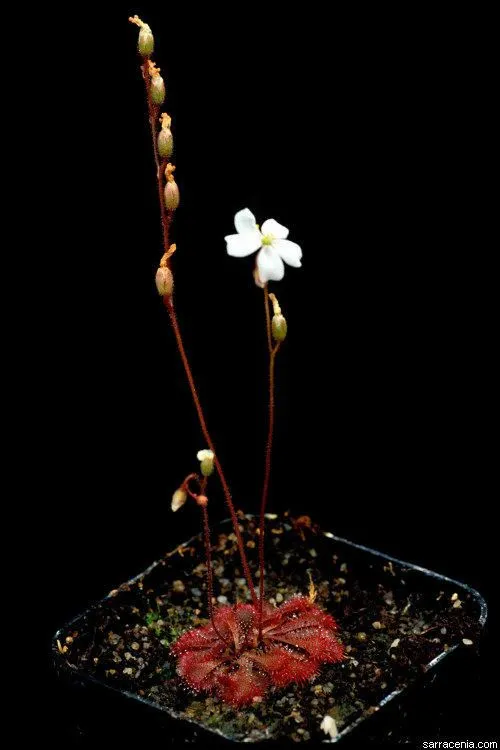
Author: Pursh
Bibliography: Fl. Amer. Sept. 1: 211 (1813)
Year: 1813
Status: accepted
Rank: species
Genus: Drosera
Vegetable: False
Observations: C. & SE. U.S.A., S. Mexico to Belize, Cuba, S. Brazil to NE. Argentina
The Dwarf Sundew, scientifically known as Drosera brevifolia, is a captivating and intriguing carnivorous plant belonging to the family Droseraceae. Originally documented in 1813 by the botanist Pursh, this fascinating species boasts a notable presence in various geographical regions including the central and southeastern United States, southern Mexico extending to Belize, Cuba, and extends its reach as far south as Brazil to northeastern Argentina.
Drosera brevifolia earns its common name, Dwarf Sundew, due to its diminutive stature. Typically measuring just a few centimeters in height, this petite plant thrives in a variety of moist, sandy, and nutrient-poor soils. Its adaptation to such environments is largely sustained through its ingenious method of nutrient acquisition.
The plant’s leaves are covered with glandular trichomes that secrete a sticky mucilage, attracting and capturing unsuspecting insects. Once ensnared, the prey is digested by enzymes secreted from the leaf glands, allowing the plant to absorb essential nutrients, particularly nitrogen and phosphorus, which are scarce in its native habitats.
Despite its carnivorous nature, the Dwarf Sundew is a delicate and beautifully intricate plant. Its leaves are typically a vibrant green, adorned with rosy or reddish glandular hairs that glisten like dewdrops in the sun. This dazzling display not only aids in attracting prey but also makes the Dwarf Sundew a sought-after species for plant enthusiasts and collectors.
In its diverse habitat range, Drosera brevifolia plays a crucial ecological role. It often coexists with other specialized plant species in bogs, pine savannas, and wet meadows, contributing to the unique biodiversity of these ecosystems. However, due to habitat destruction and environmental changes, some populations may be at risk, highlighting the importance of conservation efforts.
In summary, the Dwarf Sundew (Drosera brevifolia) is a remarkable example of nature’s ingenuity, combining beauty, complexity, and ecological significance. Its presence across a wide range of the Americas underscores its adaptability and the vital role it plays in its natural habitats.
Eng: dwarf sundew, shortleaf sundew
En: Dwarf sundew, Shortleaf sundew
Taken Apr 27, 2019 by otero jonás (cc-by-sa)
Taken Nov 21, 2021 by E Schmidt (cc-by-sa)
Taken Mar 22, 2021 by Cinthia leon (cc-by-sa)
Taken Feb 17, 2016 by EOL − anewman (cc-by-nc)
Taken Jan 24, 2021 by Christina Casiraghi (cc-by-sa)
Taken May 16, 2019 by Mary Mary Heyman (cc-by-sa)
Taken Jun 10, 2009 by EOL − Barry Rice (cc-by-nc-sa)
Taken Jun 3, 2022 by Birgitta Tittel (cc-by-sa)
Taken Jul 21, 2019 by Tracy Tracy (cc-by-sa)
Taken Jun 6, 2009 by EOL − Barry Rice (cc-by-nc-sa)
Taken Jun 10, 2009 by EOL − Barry Rice (cc-by-nc-sa)
Taken Jun 10, 2009 by EOL − Barry Rice (cc-by-nc-sa)
Taken Apr 14, 2016 by EOL − Laura Clark (cc-by-nc)
Taken Mar 31, 2016 by EOL − birdladymilam (cc-by-nc)
Taken Jun 6, 2009 by EOL − Barry Rice (cc-by-nc-sa)
Taken May 21, 2014 by EOL − brentano (cc-by-nc)
© copyright of the Board of Trustees of the Royal Botanic Gardens, Kew.
Growth habit>: Forb/herb
Family: Myrtaceae Author: (F.Muell.) K.D.Hill & L.A.S.Johnson Bibliography: Telopea 6: 402 (1995) Year: 1995 Status:…
Family: Rubiaceae Author: Pierre ex A.Froehner Bibliography: Notizbl. Bot. Gart. Berlin-Dahlem 1: 237 (1897) Year:…
Family: Sapindaceae Author: Koidz. Bibliography: J. Coll. Sci. Imp. Univ. Tokyo 32(1): 38 (1911) Year:…
Family: Asteraceae Author: A.Gray Bibliography: Pacif. Railr. Rep.: 107 (1857) Year: 1857 Status: accepted Rank:…
Family: Fabaceae Author: Medik. Bibliography: Vorles. Churpfälz. Phys.-Ökon. Ges. 2: 398 (1787) Year: 1787 Status:…
Family: Aspleniaceae Author: (Cav.) Alston Bibliography: Bull. Misc. Inform. Kew 1932: 309 (1932) Year: 1932…